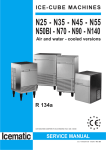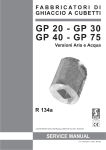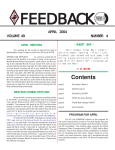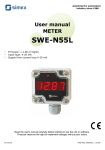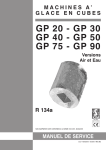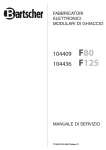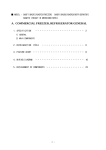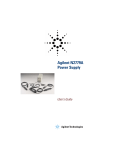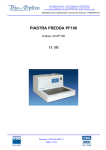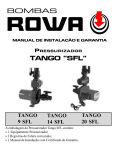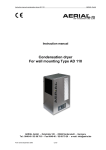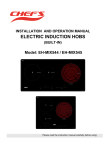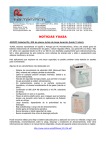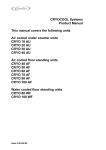Download N25-35-45-55-70-90-140 - Icematic
Transcript
ICE-CUBE MACHINES N25S / N25L / N35S N45S / N45L / N50BI N55S / N55L / N70S N90S / N90L / N140 Air and water - cooled versions R 134a ISO 9001 Cert. N° 0412/2 OUR SYSTEMS COMPLY WITH EEC DIRECTIVE 73/23 - 89/336 CEE SERVICE MANUAL Cod. 71503026/0 GB- 01/2006 - Rev. 002 GB INDEX GENERAL INFORMATION • Introduction ......................................................................................................................................................... • Unpacking ad inspection .................................................................................................................................... pag. 2 “ 2 • Locate and levelling ............................................................................................................................................ “ 3 • Water supply connections .................................................................................................................................. “ 3 • Electrical connections ......................................................................................................................................... “ 4 • Final check ......................................................................................................................................................... “ 4 • Operating instructions ........................................................................................................................................ “ 5 • Ice - forming cycle .............................................................................................................................................. “ 5 • Electrical and refrigeration systems ................................................................................................................... “ 6 • Machine main parts descriptions ........................................................................................................................ “ 7 • Trouble - shooting ............................................................................................................................................... “ 8 INSTALLATION OPERATION MAINTENANCE • Periodical maintenance and cleaning ................................................................................................................ “ 10 • Icemaker cleaning .............................................................................................................................................. “ 10 • Parts replacement procedures ........................................................................................................................... “ 10 TECHICAL DATA & WIRING DIAGRAMS Technical data ....................................................................................................................................................... “ 13 Wiring diagrams .................................................................................................................................................... “ 22 1 GB GENERAL INFORMATION A. INTRODUCTION This manual provides the specification and the step-bystep procedures for the installation, start-up and operation, maintenance and cleaning for the Icemakers. The machine cubers are quality designed, engineered and manufactured. Their ice making systems are thoroughly tested providing the utmost in flexibility to fit the needs of a particular user. This product qualifies for the following listings: These icemakers have been engineered to our own rigid sefety and performance standards. The VDE - SEV - GS seals signifity that it is listed with them and that it complies with the materials and manufacturing standard of them. These seals also signify that these icemaker models have been inspectors who reserve tha right to periodically examine production icemakers at the factory to assure continued compliance. NOTE. To retain the safety and performance built into this icemaker, it is important that installation and maintenance be conducted in the manner outlinde in this manual. B. UNPACKING AND INSPECTION 1. Call your authorized Distributor or Dealer for proper installation,. 2. Visually inspect the exterior of the packing and skid. Any severe damage noted should be reported to the delivering carrier and a concealed damage claim from filled in subjetto inspection of the contents with the carrier’s representative present. 3. a) Cut and remove the plastic strip securing the carton box to the skid. b) Remove the packing mails securing the carton box to the skid. c) Cut open the top of the carton and remove the polystyre protection sheet. d) Pull out the polystyre posts from the corners and then remove the carton. 4. Remove the front and the sides panels of the unit and inspect for any concealed damage. Notify carrier of your claim for the concealed damage as stated in step 2 above. 5. Remove all internal support packing and masking tape. 2 6. Check that refrigerant lines do not rub against ou touch other lines or surfaces, and that then fan blades move freely. 7. Check that the compressor fits snugly onto all its mounting pads. 8. See data plate on the rear side of the unit and check that local main voltage corresponds with the voltage specified on it. CAUTION. Incorrect voltage supplied to the icemark will void your parts replacement program. 9. Remove tha manufacture’s registation card from the inside of the User Manual and filling all parts including: Model and Serial Number taken from the data plate. Forward the completed self-addressed registration card the factory. GB INSTALLATION LOCATE AND LEVELLING This icemaker is designed to be installed in rooms with temperatures between 10°C and 40°C. Operating for long period out of these limits will vaid your warranty program. Before installing the machine make sure that: The ambient temperature must not fall bellow 10°C (50°F) or above 40°C (100°F). The mains water temperature must not fall below 5°C (40°F) or above 40°C (100°F). Machine is away from sources of heat and in a sufficiently ventilated area; leave at least 8 inches (20 cms.) between the machine on the back and the two sides and the wall. Machine is correctly levelled in both the left to right and front to rear directions by means of the adjustable legs. ted on the water supply machine. Fix a flexibile palstic pipe (with an inside diameter of 20 mm. and adequate lenght to reach and open vented drain) to the waste pipe fitting. In the water -cooled machine it must also be conected to the second pipe fitting (that conveys water coming from the condenser) to the drain. Level of main drain must be sufficiently below icemaker waste outlets to ensure free flow of waste water. The drain recptacle should be an, open, trapped or vented construction (see skech). N.B. Make sure that water connection are made before elettrical connections. ELECTRICAL CONNECTIONS Connect machine to water supply first and then to eletricity supply. WATER SUPPLY CONNECTIONS Connect the machine to the eletricity supply after having checked that the voltage corresponds to that on the plate on the rear panel of the machine. The mains water pressure must not fall below 1 atm. (14 Psi) or above 5 atms. (70 Psi). If pressure is above 5 atms. a pressure regulator shoult be fit- Connect the machine to the eletricity supply after having checked that the voltage corresponds to that on the plate on the rear panel of the machine. WARNING This icemaker is not designed for outdoor installation and will not function in ambient temperatures below 10°C (50°F) or above 40°C (100°C). This icemaker will malfunction with water temperatures below 5°C (40°F) or above 40°C (100°C). 3 GB Mod. N25W ÷ N140W ALLACCIAMENTO ELETTRICO.... 1) 2) 3) 4) 5) 6) Switch Socker Electrical plug Water iniet Suht off valve Water autlet from the condenser: water cooled version 7) Water autlet from the bin 8) Open vented water The maximum voltage variation should not exceed 10% of that stated on the rating plate. The machine should be connected to an independet fused or suitable power supply protected with earth. See rating plate for load requirements. Fix a solid earth ground plug to the electrical power supply wire of the machine. Be sure the plug is in conformity with the local electrical code requirement. Check by means of a tester the continuity of the earth mass from the panels to the plug earth terminal board. Mod. N25S ÷ N140 FINAL CHECK a) Check that the supply means voltage corresponds to that stated on the plate of the machine. b) Open the shut-off valve of the water supply and check there are no leaks. c) Check that the icemaker is properly levelled. d) Check that the storage bin has been wiped clean. e) Give the “Operationg instructions” manual to the owner/user and recommend him on the importance to observe the instructions and period maintenance. f) Properly fill in the certification card and mail it to Caste Mac. g) Check all refrigerant lines and conduit lines or panels to guard against vibrations and rubbing. 1) 2) 3) 4) 5) 6) Swicth Socker Electrical plug Water iniet Shut of valve Water autlet from the condenser: water cooled version 7) Water autlet from the bin 8) Open vented water 4 h) Make sure that the unit is installed in a room where the ambient temperature doesn’t fall below 10°C even winter months. i) Check that the water supply pressure is of minimum 1 atm (14 Psi). l) Give the owner the name and the complet address of the authorized Service in his area. GB OPERATION OPERATING INSTRUCTIONS Check that the shut-off valve of the water supply is open, then plug in the machine and swich on the electrical supply; the unit is now ready for automatic operation. according to the altitude being them different for any thermostat, we suggest regulation by checking if the ice cube in contact with the thermostat bulb stop the ice-maker not later than 1 minute. B) Check that water reaches the pan, that float stops water inlet before overflow and that there are no water leaks. The normal water level inside the pan must not exceed 5 - 10 mm. of its upper part. The water level can be regulated rotating the microswitch in the slit of the ralative support, after having removed the fixing screws “1” (see sketch). This operation must be done after having disconnected the electricity supply. ICE-FORMING CYCLE Check that there is no abnormal vibrations due to loose bolts and screws. Observe safety practice, disconnect machine from electricity supply before rectifying water leaks or tightening screws and bolts. E) Check an ice production cycle ensuring that the cubes are conveyed into the storage bin. F) Check the thermostat by putting a cube in contact with the thermostat bulb inside the storage bin; it must stop in 1 Minute and it will automatically resume (in a time a little bit higher) after having removed it. ATTENTION In the event the icemaker is installed with altitude higher than 500 m. from sea level, it is required a different thermostat calibration, as due to barometric pressure decrease, it is less sensitive and therefore the icemaker continues to operate even if the storage bin is full. Access to the thermostat is gained by removing the top of the wiring case; tighten clockwise the regulating scew (see sketch). As it is not possible to quantify the turns The ice cubes form around the fingers of the evaporator, inside of a pan filled with water which is continuosly moved by revolving paddies. The water level is kept constant by a float connected to a microswitch that controls a water inlet electrovalve. Dimensions of cubes can be regulated by operating on the microswitch inclination that controls the water level inside the pan. When the ice cubes have reached the required dimensions they get in contact with the revolving paddles that swings the relative paddle motor which operates a microswitch that by means of a relay it causes simultaneously: – Delivery of hot gas to the evaporator by the opening of an electrovalve, with the consequent fall of cubes from the evaporator. – The tilting of the water pan controlled by a lever of the harvest motor. The formed cubes fall on a slanting grid inside the pan and are conveyed in to the storage bin underneath. The remaining water, collected in a pan placed on one side of the bin, is then conveyed to the drain. 5 GB The tilting pan automatically returns to its horizontal position after a minute about and then it fills of water until the selected level is reached. In the meantime the hot gas valve il closes and the ice formingcycle starts again; the time of a complete cycle can vary from about 15’ to about 25’ according to water and ambient temperature. The ice quantity inside the bin is controlled through a termostat bulb fixed on one inside of the storage bin, when the cubes of ice come in contact with the bulb, the production of ice is automatically discontinued. Only after enough ice has been removed from the storage bin so as to free the bulb from the cubes, will the production resume. cycle and stops during the defrosting cycle, therefore the head pressure change on different ambient temperatures. While on N35S, N55S, N55L, N50BI, N70S, N90S, N90L, N140 there is a pressure switch that starts and stops the electric fan so to keep the head pressure constant. On water-cooled versions the head pressure is kept constant by means of an automatic valve that regulates the quantity of water cooling the condenser. (N45SW, N55SW, M50BIW, N70SW, N90SW, 140W models) On the smallest models instead, the head pressure is kept constant by a pressure switch that opens and closes a water inlet solenoid valve which supplies a metered amdint of water to the condenser in order to limit its temperature. ELECTRICAL AND REFRIGERATION SYSTEMS The “N” series machines operate on standard electrical supply 220 volts, 50 Hz, single phase. (The tolerance limit is ± 6 % of the rated base). Special voltages are eventually on specific request. Therefore, almways check nameplate for electrical information before proceeding with electrical wiring connections to the ice-cubers. The rifregerant expansion system on the cube machines is the capillary. On N25S-N25L model the condensing unit electric fan operates continuously during the ice forming 6 REFRIGERATING SYSTEM A) B) C) D) F) G) H) Compressor Eletric fan Condenser Drier Hot gas valve Evaporator Heat exchanger GB MACHINE MAIN PARTS DESCRIPTION L. FAN MOTOR (Air cooled version) The fan motor, operates during the freezing cycle to draw B. BIN THERMOSTAT The bin thermostat, which has its sensing bulb downward into the storage bin, shuts-OFF automatically the icemaker when the ice storage bin is filled and ice contacts its bulb. Lighting of the proper led paints out that the storage bin is full. cooling air through the condenser fins so to keep the condensing pressure between the 9/7 bars values. COOLING WATER INLET SOLENOID VALVE (N25SW, N35SW) A second water inlet solenoid valve, operating through an automatic hi-pressure control, is used on water cooled versions to supply water to the condenser. HI PRESSURE CONTROL (N35S, N55S, N55L, N50BI, N70S, N90S, N90L, N140) On water cooled ice makers it functions to mainlain the head pressure within the present values of 8 and 10 bars, by intermittently activating the water inlet valve to the condenser (in the water cooled models). On air cooled ice-makers it keeps the head pressure within 2 preset values (8/10 bar) by starting the electric fan of the condensing unit. HI TEMPERATURE SAFETY THERMOSTAT (All water cooled model) Fastened directly onto the rifregerant liquid line and electrically connected upstream all other controls, this safety thermostat shut-off the icemakers when senses that the temperature at the liquid line has rised to the limit of 65°C. When activated it supplies a metered amount of water to the condenser in order to limit its temperature and the refriferant operating high pressure. N. WATER REGULATING VALVE (N45SW, N55SW, N50BIW, N70SW, N90SW, N140W) This valve controls the head pressure in the refrigerant system by regulating the flow of water going to the condenser. As pressure increases, the water regulating valve opens to increases, the water regulating valve opens to increase the flow of cooling water. O. COMPRESSOR FEEDING WATER INLET SOLENOID VALVE The water inlet solenoid valve is activated only at the end of the defrosting cycle. When energized it allows a metered amant of incoming water to flow into the tilting pan untill the float closes the inlet circuit. The hermetic compressor is the heart of the refrigerant system and it is used to circulate and retrieve the refrigerant throughout the entire system. It compresses the low pressure refrigerant vapor causing its temeprature to rise and become high pressure hot vapor which is then released through the disharge valve. I. THE HOT GAS SOLENOID VALVE The hot gas solenoid valve consists basically in two parts: the valve body and the valve coil. Located on the hot gas line. During the defrost cycle the hot gas valve coil is activated so to attract the hot gas discharged from compressor to flow directly into the evaporator serpentine to defrost the formed ice cubes. MAXIMUM PRESSURE SWITCH (N45SW, N55SW, N50BIW, N70SW, N90SW, N140W) Fastened directly on to the refrigerant liquid line and electrically connected upstream all other controls, it shut off the ice-maker when senses that the head pressure reaches 15 bars. 7 GB TROUBLE - SHOOTING SYMPTOM POSSIBLE CAUSE CORRECTION Unit will not run a) Electricity supply disconnected. Check the electricity supply; replace fuse if necessary and ckeck for cause. b) Loose electrical connection. Check wiring. c) Damaged storage bin thermostat. Replace thermostat. a) Loss or undercharge of refrigerant circuit Check for leaks, repair, evacuate all the gas and recharge with R134A by weight (see nameplate). b) Water continuously entering into evaporator chamber. Check float ball, float ball microswich and water inlet valve. Replace, if necessary, the defective components. c) Moisture in the regrigerant system. Remove refrigerant charge, raplace drier, evacuate first, and then recharge. a) Under-charge of gas. Check for leak, repair, evacuate all the gas and recharge. b) Dirty condenser. Clean condenser with a non-metal brush or with a vacuum cleaner. c) Damaged fan. Repair and replace fan. d) Exceedingly warm ambient with low ventilation. Move unit to proper location. e) Partial restriction in drier. Replace drier, evacuate and recharge. f) High water level in the reservoir and water overflows. Adjust level of float ball microswitch assy. g) Scale deposit on evaporator. Polish evaporator. h) Partial restriction in the capillary tube. Remove refrigerant charge, evacuate first and the recharge. Fan doesnʼt run even if the delivery pressure is over 10 atms Detective pressure switch. Remplace. Compressor cycles intermittently a) Low voltage. Check electrity supply. b) Dirty condenser. Clean. Machine runs but makes no ice Low ice production 8 GB DIFETTI CAUSA RIMEDI SUGGERITI c) Air circulation blocked. Move unit to cooler location. d) Non-condensable gases in system. Purge-off. e) Detective compressor electrical components. Replace electrical components. f) Mechanical or electrical failure inner compressor. Remplace compressor. Icecubes are too low a) Water level in the pan is too low. Adjust level by raising the float ball micro-swicht assy. Icecubes are too long a) Water level in the pan is too high. Adjust level by lowering the float ball microswicht assy. b) Water solenoid valve is not water-tight. Check the valve in order to remove eventual obstructions, or replace defective parts. a) Incorrect position of revolving paddles. Center the paddles in accordance with the evaporator components. b) Unit is not properly levelled. Check the machine level by working with the adjustable feet. a) Impure water. Clean the water inlet filter. b) Calcareous water. Install a water softener. a) Detective water seal. Check and repair. Unproper shape and/or irregular dimension of cubes Deposits in the pan Water leaks 9 GB MAINTENANCE PERIODICAL MAINTENANCE AND CLEANING N.B.: Cleaning and maintenance especially will vary, depending upon ambient and use conditions. In particular affect: hard water, ice volume produced and location requirements. The following maintenance procedures should be scheduled once per year al least from the local service Agency. Be sure the electrical power supply of the machine is OFF, before starting any maintenance and cleaning procedure. a) Close the water supply, shut-off valve, disconect the water inlet pipe and remove the strainer from its seat in the water inlet elettrovalve withdrawing it bay means of pilers. Clean the strainer under running water and reassemble. b) Check that the ice maker cabinet is levelled in side-toside and front-to-rear directions. c) Check paddle shaft motor and harvest motor operation. e) Add hot water to the ice storage bin and thoroughly wash and rinse all surfaces within the bin. f) Clean and sanitize the ice storage bin frequently. PARTS REPLACEMENT PROCEDURES A) ADJUSTABLE LEGS FOR N55S÷N90L MODELS Using the couplings and adjustable feet supplied and screwing them on the base nipples the icemaker can be placed at 9,5 cm. abt. from ground level. Extended feet are available on request to adjust the icemaker at 16 cm. about from ground level. A kit of extension feet can be supplied on request also for the N35S model. The adjustment should be performed during initial installation of the cabinet and any time the cabinet is moved from the original location to another site. N.B.: (WARNING) Be sure the electrical power supply and the water supply are OFF, before starting any removal and replacement procedures, as a precaution to prevent possible personal injury or damage to equipment. d) If you think it opportune, check by means of a gauges the delivery pressure and the evaporator temperature. e) Clean the air-cooled condenser using a nonmetal brush or a vacuum cleaner. B) COMPRESSOR REPLACEMENT a) Remove the rear panel on the N25S-N25L model and the rear panel grid on N35S model f) Check that fan blades move freely and are not touching any sourfaces. On N45S÷N140 models remove the rear panel grid and the side panels. g) Check for refrigerant leaks. h) Check for water leaks. Pour water down bin drain to be sure that drain line is open and clear. i) Check operation of the bin thermostat. Remove the cover and disconnect the electrical leads from the compressor junction box. Bleed off or blow the refrigerant charge through the valve. Unsolder and disconnect both the suction line and the discharge line (from the compressor). ICEMAKER CLEANING a) Remove the top panel. b) Remove all ice from the storage bin. c) Close the water supply shut-off valve. d) Fill tilting pan with a solution of water and citric acid (200-400 grs. of citric acid in one litre of water) and by means of a brush clean the inside of the tilting pan and the evaporator fingers. Start the icemaker to tilt the pan, rinse with clean water in abudance and repeat cleaning three times. 10 Remove compressor mounting bolts and the compressor from the unit base. Always install a replacement drier, anytime the sealed refrigeration system is open. Do not replace the drier until all other repairs or replacements have been completed. To install the replacement compressor follow previous steps in reverse. Thoroughly evacuate the system to remove moisture GB and non-condensables after compressor replacement. F) EVAPORATOR ASSEMBLY REPLACEMENT a. Remove the top cover. Before proceeding with the refrigerant charge check nameplate for specific refrigeration charge for individual cuber. b. Remove six screws securing the paddle shaft supports (two) and the paddle motor support; then remove the paddle motor/paddle shaft/supports assembly. C) AIR COOLED CONDENSER REPLACEMENT Remove the rear panel grid on N25S, N25L and N35S models. On N45S÷N140 and upper models remove the front panel grid and the side panels. Remove the screws which attach the condenser to the unit base. Bleed off or blow the refrigerant from the system. c. Remove the bolts securing the evaporator supports (two) to the cabinet. d. Sideways remove the evaporator supports. e. Unsolder the capillary tube, the hot gas solenoid valve tube and the suction line. f. To install the replacement evaporator assembly follow previous steps in reverse. g. Install the replacement drier; thoroughly evacuate the system and proceed with the refrigerant charge. Unsolder the refrigerant lines from condenser and remove it from the unit. Install the replacement condenser following previous steps in reverse. Thoroughly evacuate the system to remove moisture and non condensables; then proceed with the charge of FREON R134a. D) DRIER REPLACEMENT Remove the rear panel grid on N25S, N25L and N35S Models. On N45S÷N140 models remove the side panel grids. Bleed off or blow the refrigerant charge through the Henrytype valve. Unsolder the capillary tube from one end of the drier and the refrigerant line from the other end. To install a replacement drier remove factory seals. Thoroughly evacuate the refrigerant system. G) WATER RESERVOIR/TILTING LEVER/SUPPORT ASSEMBLY REPLACEMENT a. Remove screws and top cover. b. Remove the gear motor/paddle shaft/support assembly. c. Remove the screws securing the evaporator supports (two). d. Sideways remove one evaporator support support as well as one reservoir gudgeon support. e. Slightly lift the evaporator and remove the water reservoir assembly. f. To install the replacement water reservoir assembly follow previous steps in reserve. H) WATER INLET ELECTROVALVE REPLACEMENT a. Remove the rear panel. b. Check that water supply is closed. Charge the system with refrigerant by weight (see nameplate) and check for leaks. c. Disconnect the water supply connection pipe from the valve and that of the electrovalve from the reservoir. E) FAN MOTOR REPLACEMENT Remove the rear panel grid on N25S, N25L and N35S models. On N45S÷N140 models remove the side panel grids. d. Break contact from the electrovalve and remove the screws (two) securing the electrovalve to the relevant frame. Trace the electric wire leads of fan motor and disconnect the same. Remove the bolts securing the fan motor assembly to the cabinet base and the remove the assembly. Install the replacement fan motor following previous steps in reverse anc check that the fan blade do not touch any sourface and move freely. e. To install the replacement electrovalve follow previous steps in reverse; before installing the water supply pipe check that the gasket is not defective. I. PADDLE MOTOR REPLACEMENT a. Remove the top cover. b. Remove six screws securing the paddle shaft supports (two) and the paddle motor support. 11 GB c. Trace the electric wire leads of paddle motor and disconnect the same; then remove the paddle shaft motor assy. d. Remove the paddle shaft assy from the paddle motor gudgeon (or guide pin). e. To install the replacement paddle motor follow previous steps in reverse. L) HARVEST MOTOR REPLACEMENT a. Remove the top cover. f. Install the replacement harvest motor on the support and apply the cam; make a Ø 3 mm hole on the motor shaft and to do it take as a guide the hole already existing on the cam. g. To install the replacement harvest motor assy follow previous steps in reverse. M) THERMOSTAT OR RELAY REPLACEMENT a. Remove the rear panel on N25S model. On N35S÷N140 models remove the top cover. b. Remove the terminal box cover. b. Remove the screws securing the harvest motor to the cabinet base. c. Remove the screws securing the terminal box to the cabinet. c. Remove the seeger from the cam pin. d. Slightly lift the terminal box and remove the screws securing the thermostat or the Relay to the box same. d. Trace the electric wire leads of harvest motor and disconnect the same; then remove the harvest motor/cam/support assembly. e. Remove the lock pin securing the cam to the motor shaft and the screws joining the harvest notor to the relative support. 12 e. Remove the Relay or the Thermostat; in this last case remove the supports securing the bulb in the storage bin first, the lift it from the storage bin through the proper slit. f. To install the replacement thermostat or relay follow previous steps in reverse. 134A 134A 134A 134A 134A 134A 134A 134A 134A 134A 134A 134A 134A 134A 134A 134A 134A 134A 134A 134A 134A 134A 134A 134A N21S A N21S W N25S A N25S W N25L A N25L W N35S A N35S W N45S A N45S W N45L A N45L W N55S A N55S W N55L A N55L W N50BI A N50BI W N70S A N70S W N90S A N90S W N140 A N140 W ELECTROLUX GL60TB 220/50HZ ELECTROLUX GL60TB 220/50HZ ELECTROLUX GL45TB 220/50HZ ELECTROLUX GL45TB 220/50HZ ELECTROLUX GL45TB 220/50HZ ELECTROLUX GL45TB 220/50HZ ELECTROLUX GL90TB 220/50HZ ELECTROLUX GL90TB 220/50HZ ELECTROLUX GL90TB 220/50HZ ELECTROLUX GL90TB 220/50HZ ELECTROLUX GL90TB 220/50HZ ELECTROLUX GL90TB 220/50HZ UNITE' HERMETIQUE CAE4448Y 220/50HZ UNITE' HERMETIQUE CAE4448Y 220/50HZ UNITE' HERMETIQUE CAE4448Y 220/50HZ UNITE' HERMETIQUE CAE4448Y 220/50HZ UNITE' HERMETIQUE GP14TB UNITE' HERMETIQUE GP14TB UNITE' HERMETIQUE CAE4448Y 220/50HZ UNITE' HERMETIQUE CAE4448Y 220/50HZ UNITE' HERMETIQUE CAJ4461Y 220/50HZ UNITE' HERMETIQUE CAJ4461Y 220/50HZ UNITE' HERMETIQUE CAJ4511Y 220/50HZ UNITE' HERMETIQUE CAJ4511Y 220/50HZ TYPE COMPRESSOR 2,5A 2,4A 3,6A 220 220 220 3,7A 3.6A 340 340 5,2A 4,8A 640 640 4,2A 4,7A 410 410 3,6A 360 3,6A 3,6A 360 360 3,6A 3,6A 3,6A 3,6A 360 360 360 220 2,4A 2,7A 220 220 1,4A 140 1,4A 1,4A 140 140 1,6A 2A 160 140 2A 160 4A 4,5A 3,8A 4A 3A 3,3A 3A 3,3A 2,8A 3A 2,8A 3A 2A 2,1A 2A 2,1A 2.0A 2,1A 1,2A 1,2A 1,2A 1,4A 1,8A 1,8A COMPRESSOR MAX. MEDIUM POWER AMPER AMPERE IN WATT * -10 9 9.5 9 -5 -8 11 9 -6 -3 11 9 9 11 -4 -8 -5 -8 9 11 -8 -6 9 9 9 9 9 8-10 10 8-10 8-10 8-10 9 9 9 -6 -6 -4 -6 -4 -4 -2 0 0 0 -2 -8 -3,3 -18 -17 -14 -13 -12 -12 -16 -16 -18 -16 -18 -16 -14 -13 -14 -13 -16 -15 -13 -13 -13 -13 -17 -17 22.5 23.5 15.5 16 12.2 12.5 13.5 14.5 11.5 12 11.5 12 7.8 8.0 7.8 8.0 8.2 8.6 5.3 5.3 5.3 5.8 7,5 7,5 90/17g 90/17g 60/17g 60/17g 60/17g 60/17g 35/17g 35/17g 35/17g 35/17g 35/17g 35/17g 35/17g 35/17g 35/17g 35/17g 20/17g 20/17g 15/17g 15/17g 15/17g 15/17g 15/19G 15/19G 84 19 48 11 40 9 37 7 37 7 37 7 30 5,5 30 5,5 22 4,7 15 2,8 15 2,8 21 6 ** EXPRESSED IN LITRES FOR HOUR WITH WATER TEMPERATURE OF 15°C AND AMBIENT TEMPERATURE OF 21°C 9 11.5 9 15 9 13.5 9 13 9 12.5 9 12.5 9 12 9 12 10 14 8-10 8-10 8-10 11 9,5 11,5 CUBES FOR CONDENSING EVAPORATION CONDENSING EVAPORATION ELECTR. WATER CYCLES AND PRESSURE TEMPERATUPRESSURE TEMPERATURE CONSUMPTION CONSUMPTION WEIGHT SINGLE STARTING RE STARTING END CYCLE END CYCLE ON 24 HRS/KW ** CUBES IN GRAM CYCLE (BARS) CYCLE (°C) (BARS) (°C) N *ABSORVED POWER AT EVAPORATION TEMPERATURE OF -15°C GAS MACHINE GB MEDIUM AND MAXIMUM ABSORBITION ON THE "N" LINE MACHINES AT 32¡C ROOM TEMPERATURE CONDENSING PRESSURE AND EVAPORATOR TEMPERATURE AT STARTING AND END CYCLE AT 32¡C ROOM TEMPERATURE TECHNICAL DATA FOR ICE CUBES MACHINE GB WIRING DIAGRAMS N25S AIR 14 GB N25L - N35S AIR 15 GB N25S - N25L - N35S WATER 16 GB N45S / N45L / N55S / N55L / N70S / N90S / N90L AIR 17 GB N45S / N45L / N55S / N55L AIR 18 GB N50 B.I. AIR 19 GB N50 B.I. 20 WATER GB N70S / N90S / N90L WATER 21 Via del Lavoro, 9 C.P. 172 I - 31033 Castelfranco Veneto (TV) Italy Tel. (0423) 738452 - Fax (0423) 722811 E-mail: [email protected] Web-site: www.castelmac.it Cod. 71503026/0 GB- 01/2006 - Rev. 002
























